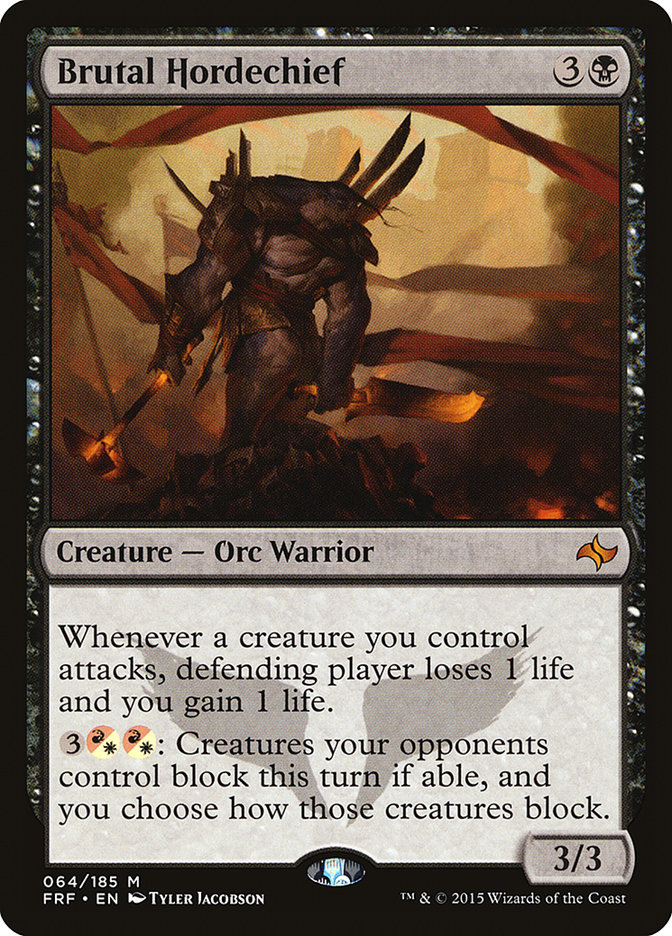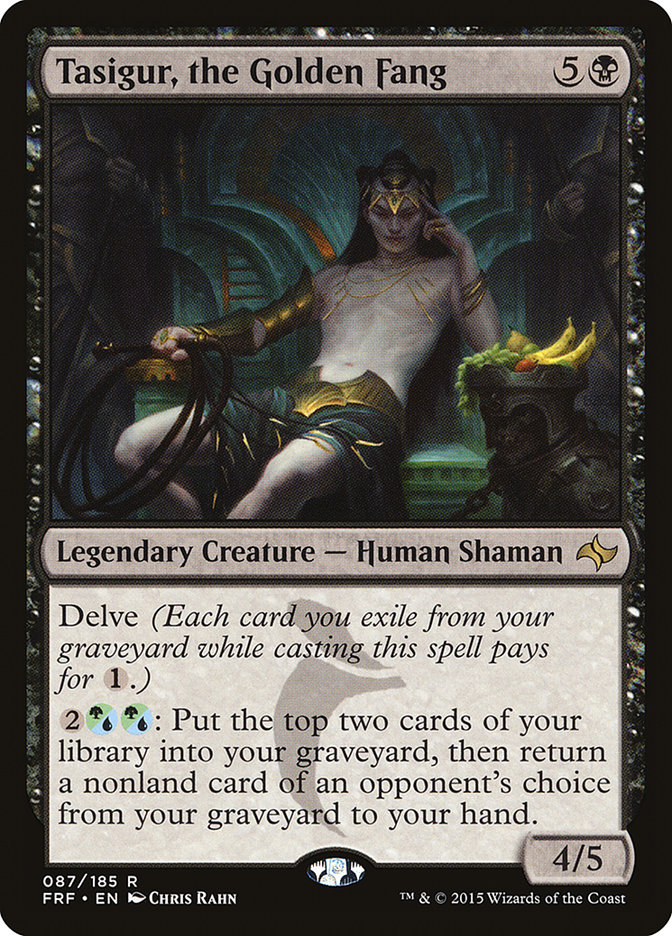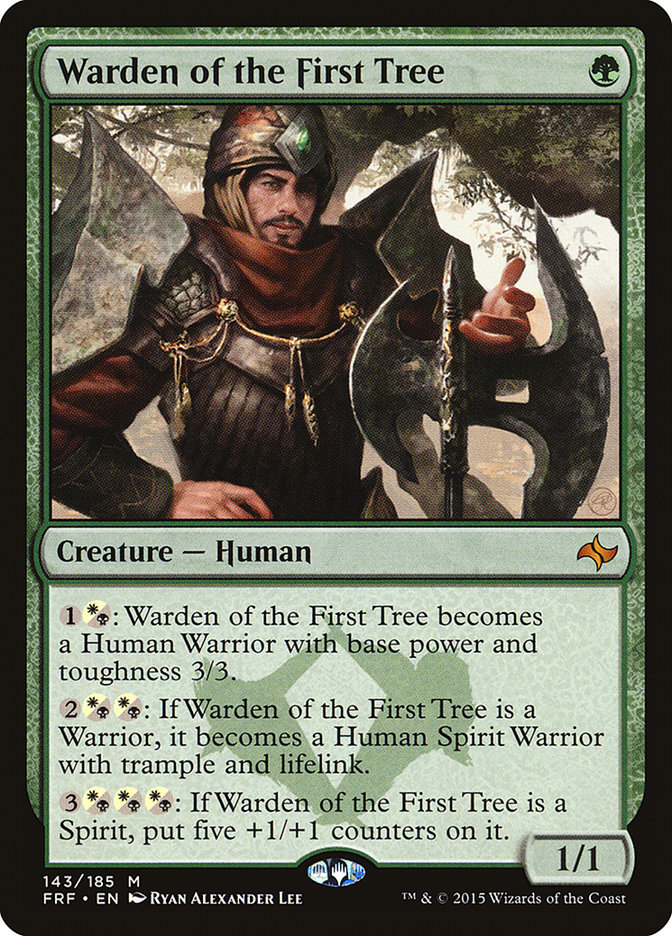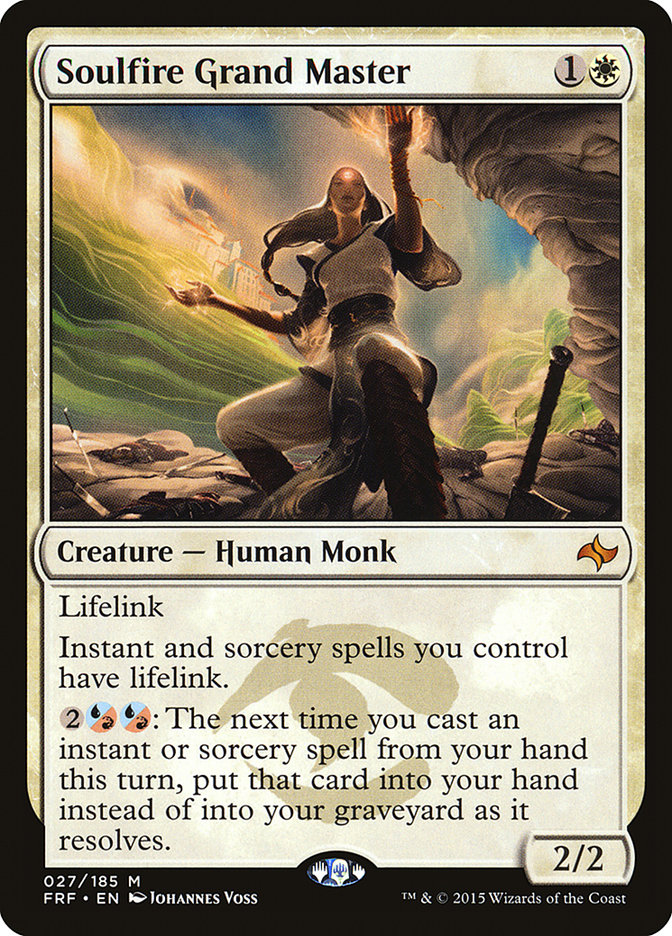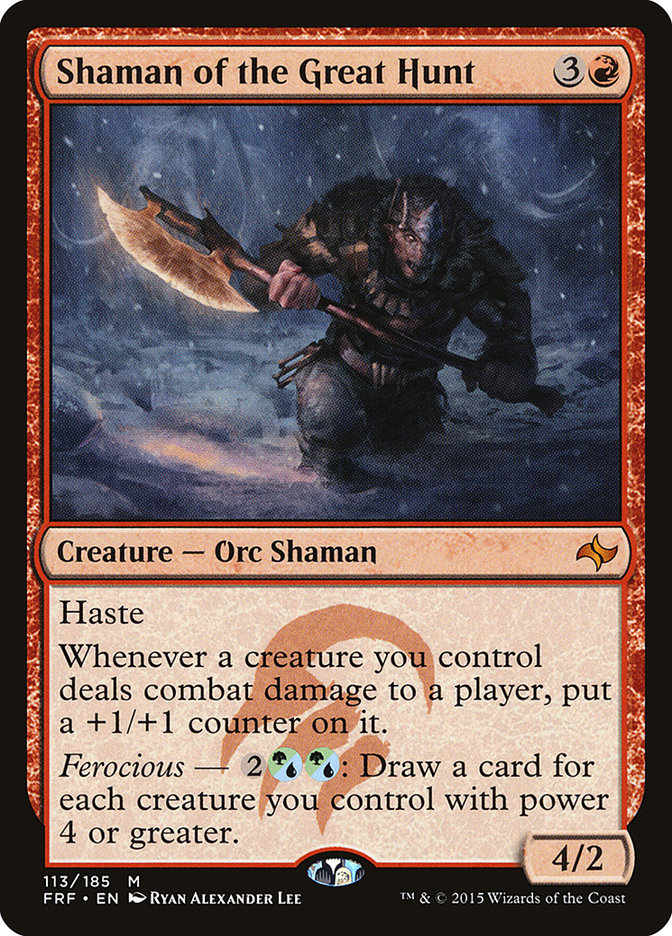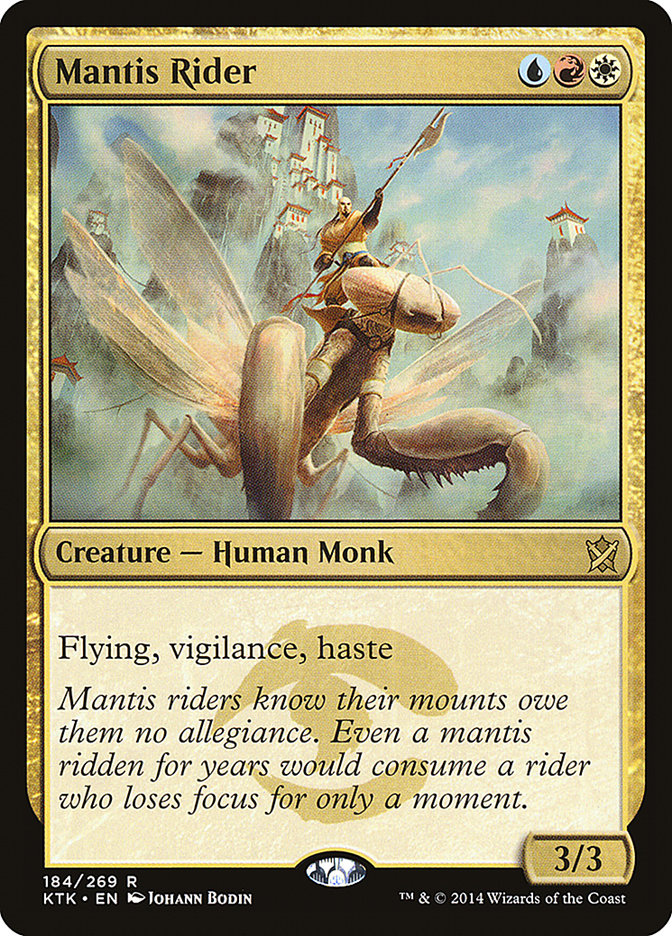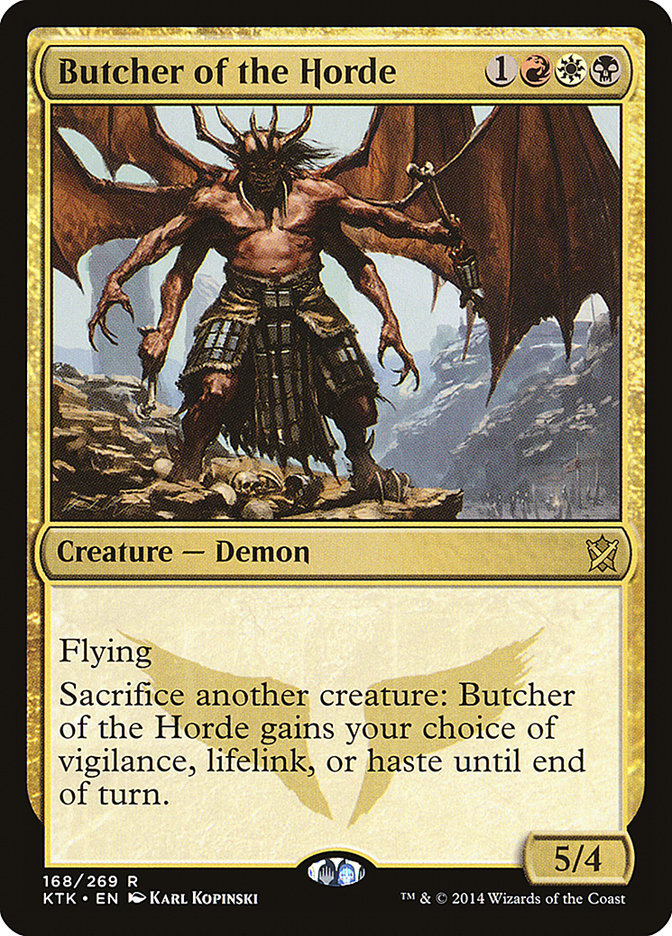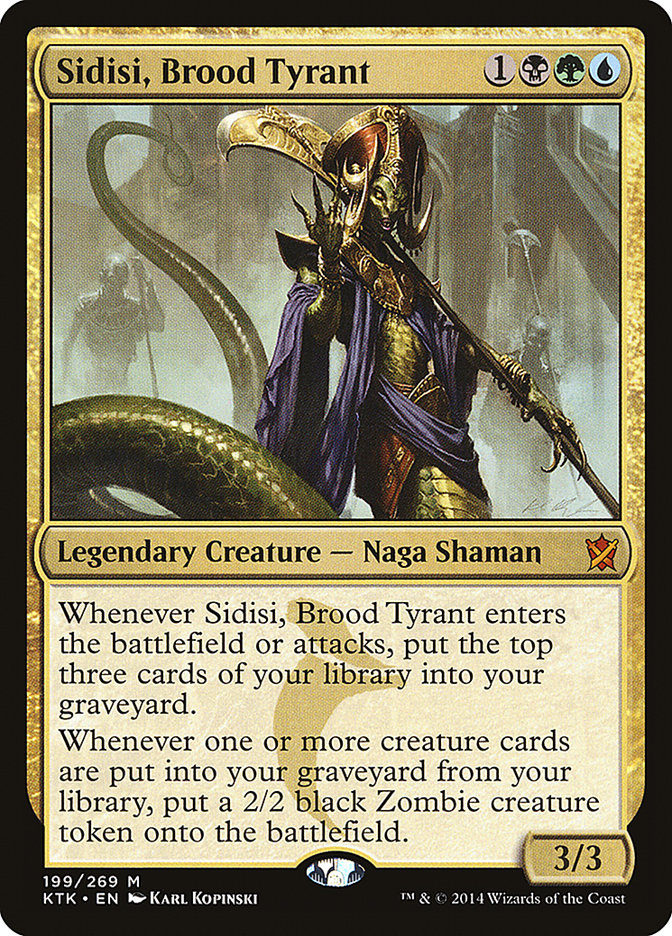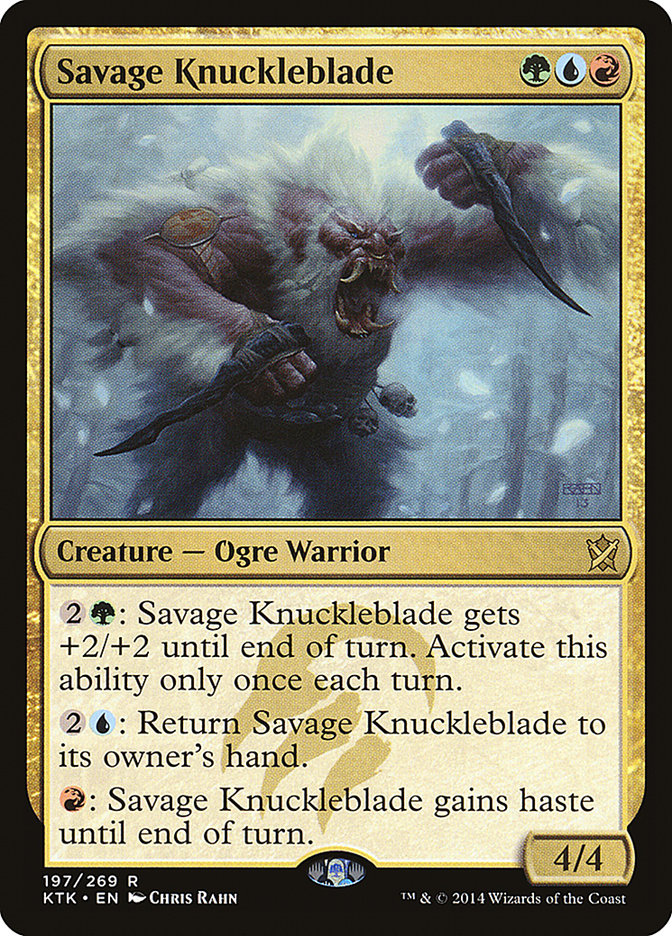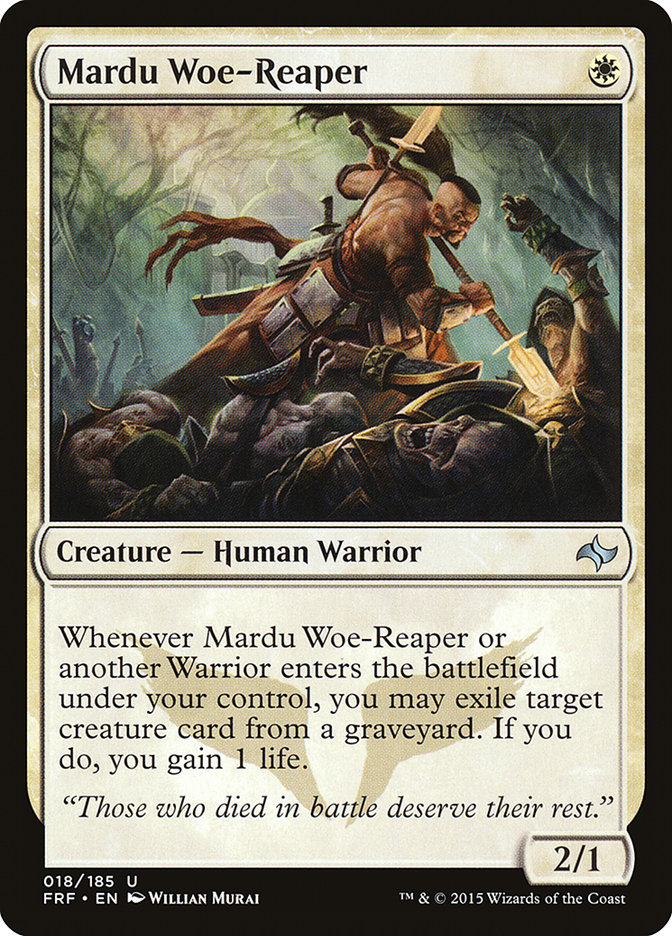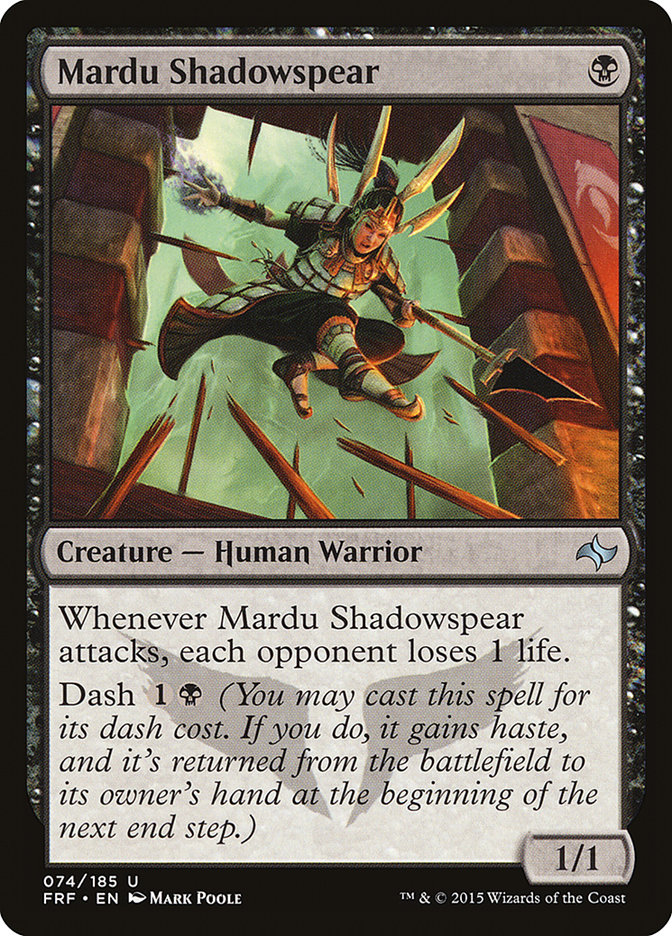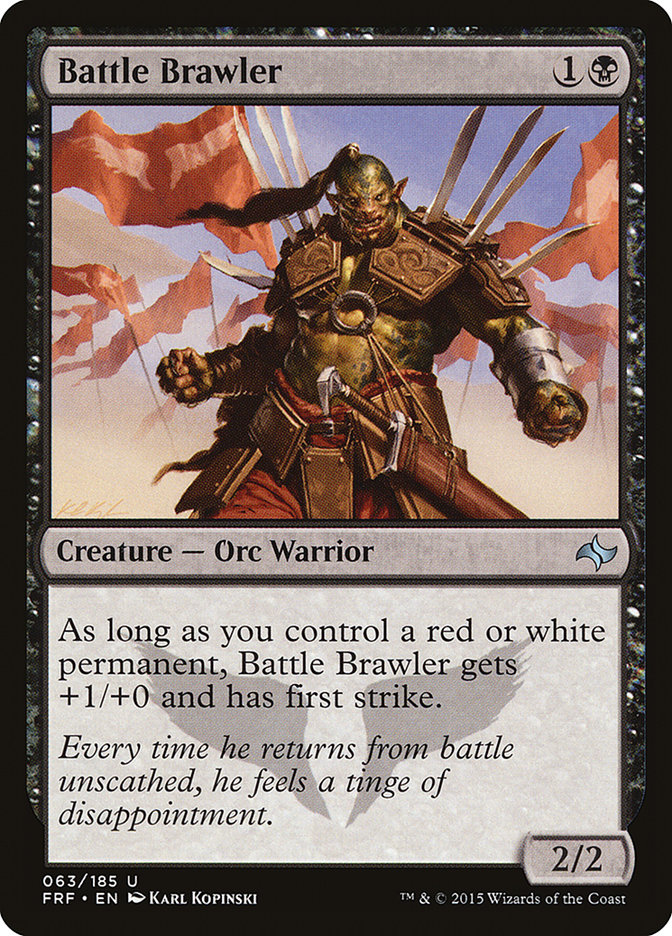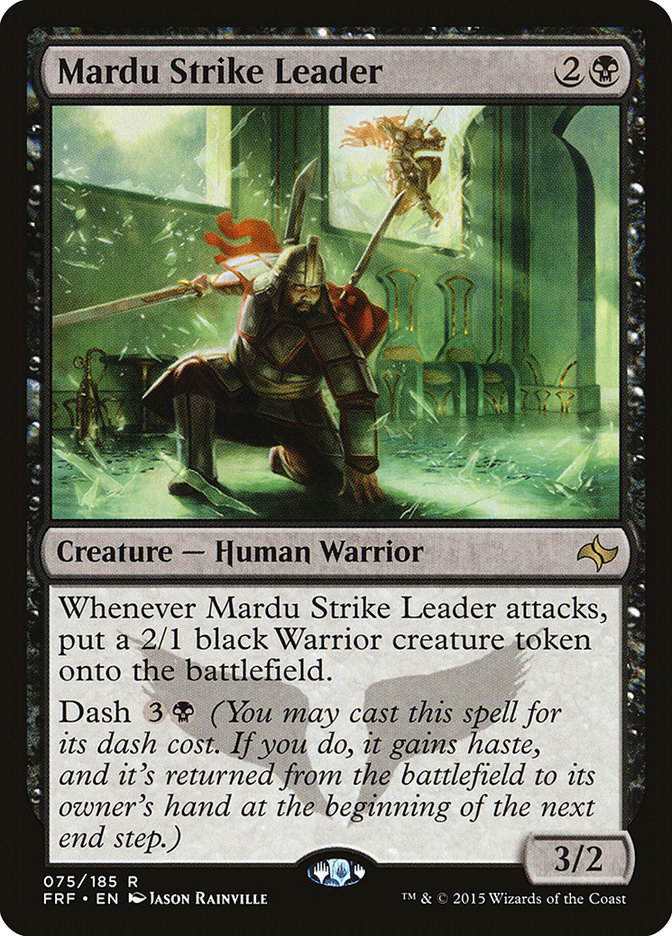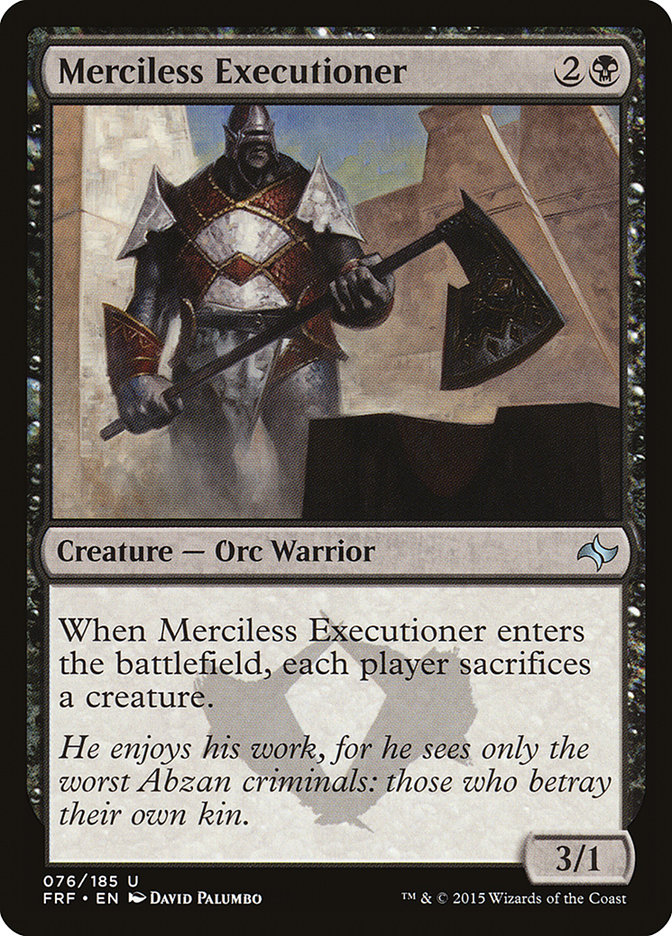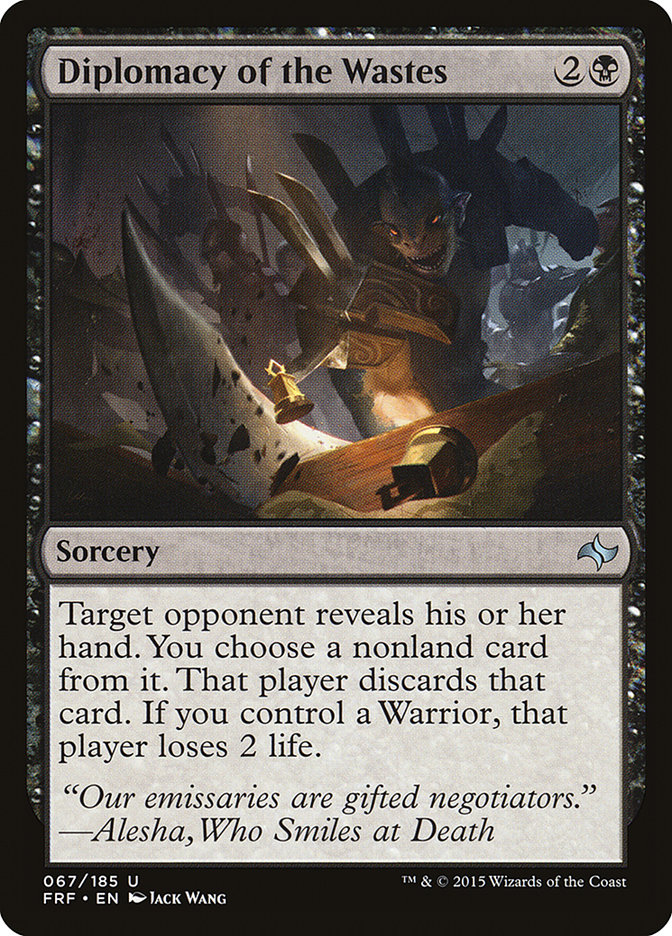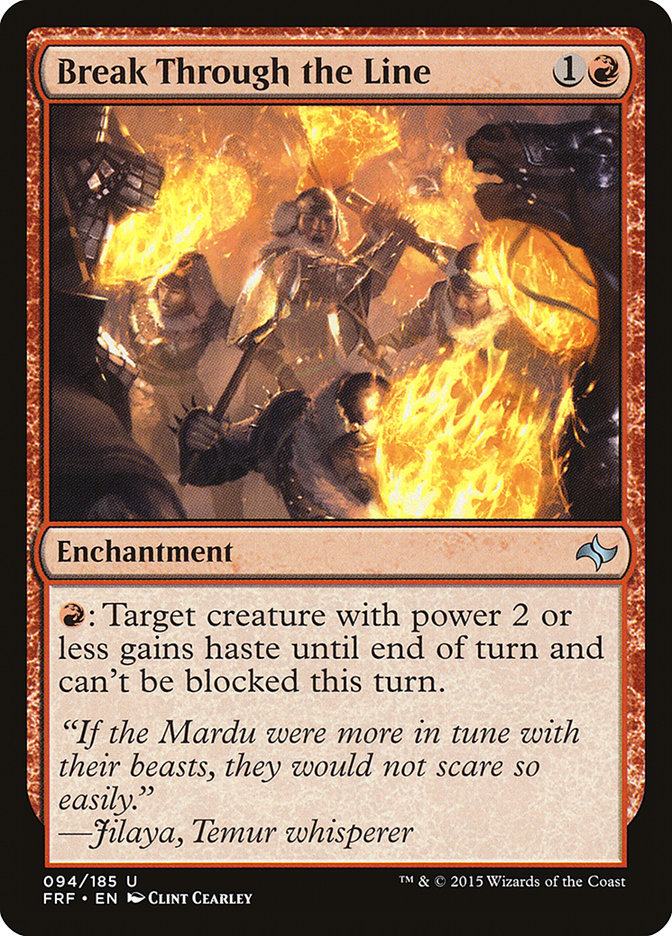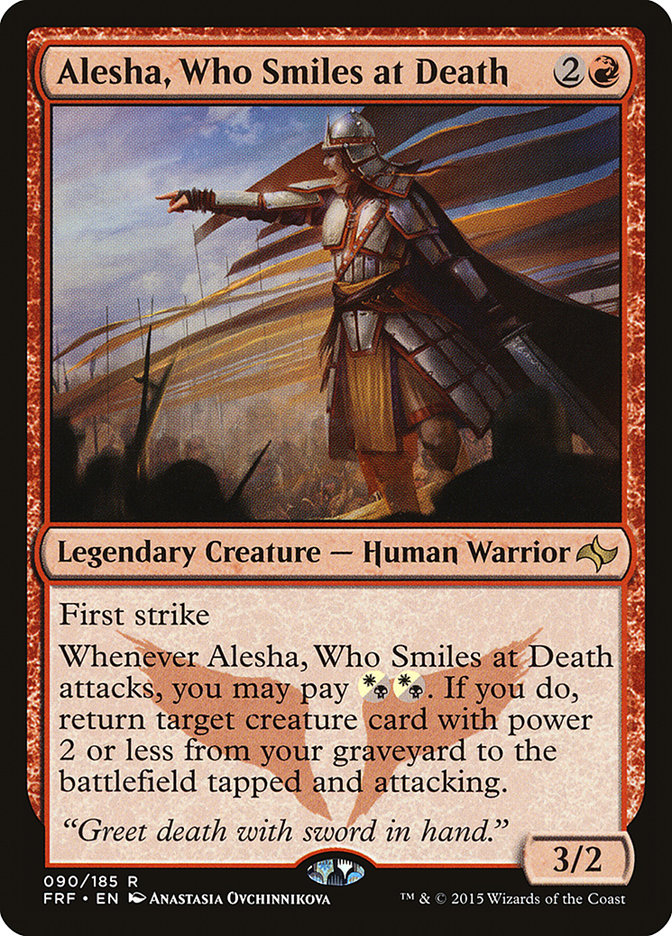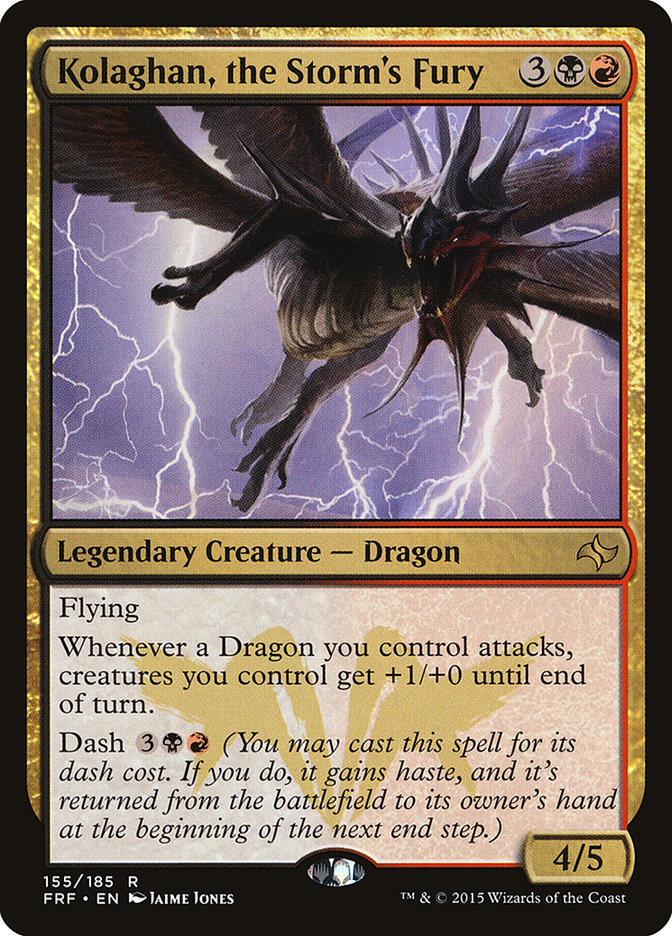That card is disgusting, right?
The new Hellrider? Well, it doesn’t have haste.
Yeah, but it drains them, and if you ever get to untap, creature combat is basically completely over, right?
Err, yeah…
…
So, I guess this card exists now.
Fate Reforged adds only 165 new cards to the Standard format. It’ll be interesting to discover what it means that so much of the power of the set is tied
up in the hybrid activation rares and mythics. There are ten in total, with nearly all ten tournament-quality considerations and half of them among the top
cards in the set.
I found it interesting that each faction appears to have a super bomb and then an interesting possible build-around. It reminds me a bit of the cycle of
bomb three-color cards from Khans of Tarkir.
That “cycle” was so strong, it virtually ensured each faction would have at least one major archetype to take advantage of their overpowered bomb. While
the Fate Reforged cycle looks like another cycle of three-color cards, they are actually secretly two-color cards that give you two choices as to which
colors to play them as. This means not only do these five cards represent ten color combinations, they can actually go in a huge range of decks once you
factor in all of the three-color combinations you might put them in.
It’s kind of funny, but there really is an ace for each two-color combination now, just like there was for each supported three-color faction!
My intuition is that understanding this cycle will be the key to understanding Fate Reforged, so today, I’d like to start with one of the powerhouses of
the cycle with the most depth to it: Brutal Hordechief. There are a lot of different ways to exploit it, and exploring them all will help give us more
understanding of what the new format may look like. An in-depth breakdown of Soulfire Grand Master can be foundhere, and discussion on Warden of the First Tree can be found here.
Evaluating Brutal Hordechief is easiest when we start with Hellrider as a baseline. Hellrider is an extremely powerful card. We’re talking really good. It
would be really good in the new format as well, an instant all-star. So, how does Brutal Hordechief compare to Hellrider?
Well, on one side of the equation, we are losing haste, which is effectively four less damage. That is a major, major hit. On the other side, we have four
small to medium edges that aspire to add up to enough to be back in the same league. Even if Brutal Hordechief was slightly behind, there is room for cards
weaker than Hellrider in top tier Standard. Hellrider isn’t even legal, so that’s not really the bar.
Perhaps the most important difference between Hellrider and Brutal Hordechief is that the Hordechief drains rather than just damaging. This will often mean
gaining several life a turn, which can nearly make up for the lack of haste in racing situations. Besides, there are so many good ways to pay life right
now (fetchlands, painlands, Thoughtseize, Read the Bones, etc) that a little lifegain is exactly what some decks want.
A very minor difference between Brutal Hordechief and Hellrider is the mana cost. While Brutal Hordechief requires double of a non-black color to use its
hybrid ability, you actually get a huge amount of the value out of the static. With just a single black in the cost, Brutal Hordechief is actually
relevantly easier to cast in some decks. That said, Hellrider could still get full value in a mono-color deck, so Brutal Hordechief is a little more
restricted on options for color combinations.
Another minor advantage to Brutal Hordechief is the relevant creature type. Warrior doesn’t have a million synergies going for it or anything, but there
are a couple that could have applications, like Chief of the Edge and Obelisk of Urd.
Finally, we come to the activated ability. If Brutal Hordechief didn’t have this ability, it would still be a possible tournament card. However, the hybrid
ability is why the card is actually great. You’re going to get to untap with it against creatures sometimes, and when you do, you are going to absolutely
devastate them. There is some possibility of getting blown out and wasting mana, but careful and intelligent use of the Brutal Hordechief’s hybrid ability
is going to be a game-winning play in a ton of games.
Getting to choose how all of your opponents creatures block is a very big game. First and foremost, you can make all of your opponent’s creatures block the
same creature, making all of your other creatures unblockable. Combine this with the lifedrain ability and that play alone is going to win the game a lot
of the time.
If you can’t just win the game outright, you can also just make your opponent do all of the worst possible blocks. For instance, picture Sidisi blocking
Brimaz while the zombie token blocks the Brutal Hordechief, while their Hornet Queen and all of their Wasps gangblock the 1/1 Cat token.
And that’s part of the key to Brutal Hordechief. You can attack with it on most boards and have it never die. Hellrider often died in combat, or would if
it attacked. Brutal Hordechief doesn’t have to be scared if you’ve got mana for its hybrid. Just be careful they don’t blow you out by Murderous Cutting
your Brimaz and then eating your Brutal Hordechief. Remember, you can attack first, so that you get the cat token, then before blocks, activate the hybrid
ability.
It’s pretty corner case, but remember that if the game goes really long, you can potentially drop the Hordechief and use its ability in the same turn!
Does Brutal Hordechief die to removal? Absolutely, and lots of it. However, there are a ton of awesome creatures that die to removal and still dominate.
Just look at Goblin Rabblemaster! Even if your opponent can untap and kill the Hordechief before its hybrid is online, you are often going to get at least
one “hit” from the static ability as a sort of enters-the-battlefield effect.
The first concept that crossed my mind with the Hordechief is Warriors. After all, Warriors was only a few cards short of being somewhere good, and Fate
Reforged has a lot of new options to try. The first Warrior deck I wanted to try was B/W, as Chief of the Edge is one of the best Warrior incentives.
Creatures (29)
- 4 Tormented Hero
- 4 Chief of the Scale
- 4 Chief of the Edge
- 4 Bloodsoaked Champion
- 1 Mardu Hordechief
- 4 Brutal Hordechief
- 4 Mardu Strike Leader
- 4 Mardu Woe-Reaper
Lands (23)
Spells (8)

Previous Warrior decks usually had to go three colors just to get enough playable Warriors. Fate Reforged has a lot of options to fill in the gaps.
Mardu Woe-Bringer’s ability isn’t exactly breathtaking, however, we were already on board with 2/1s for 1 with a drawback, like Tormented Hero. The
Woe-Bringer is untapped (if it needs to block), gains a non-trivial amount of life in some games, and even provides a little graveyard hate for fighting
Hornet Queen, Soul of Innistrad, Alesha, Who Smiles At Death, Flamewake Phoenix, Bloodsoaked Champion, and the delve mechanic.
If we want other options for one-drop Warriors, Mardu Shadowspear at least delivers two damage a turn for one-mana.
I didn’t include Mardu Shadowspear because of how much it wants to go in a deck with a lot of removal (to get it through), since it is poor at actual
creature combat. It does have advantages against Sylvan Caryatid, however, not to mention if you ever need its dash ability for hasty reach.
The dash ability gives you two things here. Haste is obvious, for when you have plenty of mana and just want to maximize damage. However, it’s also a
valuable tool for fighting End Hostilities, Drown in Sorrow, and Anger of the Gods, since it keeps the Shadowspear “invisible” on your opponent’s turn.
One final bonus to Mardu Shadowspear is its cost of black instead of white. It’s not that big of a deal, but since these decks are generally going to have
more black mana than white, it will be a turn 1 option more often. If you end up playing something three-color, it can be cast off of Bloodstained Mire and
Urborg, which is generally going to lead to more turn 1 looks than a white one-drop would have.
I didn’t include Mardu Skullhunter in this list, as attrition doesn’t seem like the battle Warriors wants to be fighting on. That said, it’s possible that
opponents may be attrition-based enough to warrant it, main or sideboard. Chief of the Scale is far weaker than Chief of the Edge and an easy possible
swap. That said, Chief of the Scale is kind of sweet when you get to use Brutal Hordechief’s hybrid, as it greatly increases the possibility of combat
blowouts.
Battle Brawler is another two-drop option, but it really doesn’t want to be in a deck with eight or more black one-drops. It’s kind of on the weak side
anyway, but if you were going to Battle Brawl, you’d want to put it in a mostly white or mostly red deck, though first strike is nice with the Brutal
Hordechief hybrid ability.
Sultai Emissary is a Warrior, but this one is more of a blocker than an attacker. If does give you some sweeper resistance (and manifesting a Brutal
Hordechief could be big), but I’d want some amount of sacrifice theme to make it worth it. That said, if you’re playing a Butcher of the Horde deck,
suddenly the Sultai Emissary starts looking a lot more attractive. Brutal Hordechief is also not the worst way to turn Sultai Emissary on, it’s just not
reliable, and when you can do it, you’re often winning anyway.
Athreos, God of Passage would seem to suggest we look to it when we start getting a lot of mana symbols in play, which Chief of the Edge and Chief of the
Scale contribute towards. However, the format is very hostile towards Athreos. There’s too much removal and too many sweepers to reliably keep the board
full of weenies. Additionally, there’s a lot of exile and ways to get it off the table if it ever would become a problem. Add to this how many great
three-drops are in the format, and it doesn’t look good for Athreos.
Mardu Strike Leader, on the other hand, is a three-drop I can really get behind. This is a card with basically two modes. First, as a three-drop, it is
sort of Brimaz, albeit weaker. The tokens are more relevant, but the smaller body makes the Strike Leader very vulnerable. This sort of ability really
rewards you for playing more removal (like Brimaz’s), so it’s possible this card is better suited to a more midrange style of deck.
The dash ability is actually super sick on Mardu Strike Leader. It can be disrupted by instant speed removal; but barring that, you sort of have this
“tome” that lets you spend four mana to draw and cast a 2/1 creature, plus attack your opponent for three. This is particularly great against people
playing sorcery speed sweepers, which would normally be quite effective against a strategy like this.
Merciless Executioner lends itself better to decks with creatures you want to kill, like Sultai Emissary, or creatures that cost you almost nothing, like
Satyr Wayfinder. That said, being able to sacrifice a Bloodsoaked Champion or a 1/1 token could be a nice way to fight bigger creatures, like Siege Rhino.
Even when you have to sacrifice your Merciless Executioner, it’s only one mana more than Cruel Edict.
I think Diplomacy of the Wastes may sneak up on people. After all, it does look expensive compared to Thoughtseize. However, having access to more than
four Thoughtseizes is a big deal in some spots, and the extra two damage can really add up. Remember, Blightning was format-defining for two years and is
just a harder to cast Mind Rot with three damage attached.
Yes, Diplomacy of the Wastes requires a Warrior for you to get the extra damage, but it’s not the end of the world if you don’t get it. What’s big is the
ability to consistently make your opponent discard their sweeper the turn before they can play it while keeping the pressure on your opponent’s life total.
Another option for Brutal Hordechief in B/W is a Soul Sister’s shell, exploiting the great interaction with Ajani’s Pridemate. Remember, each drain for one
is a separate trigger, so Ajani’s Pridemate is going to become immense immediately!
Creatures (15)
Planeswalkers (4)
Lands (24)
Spells (17)

I thought it was outside the scope of this deck, but Mardu Woe-Reaper is another possible repeatable source of lifegain.
It’s a minor point, but Nomad Outpost (and all of the tri-lands) are underplayed as dual lands. When you’re playing two colors and already have all twelve
of your dual lands (Temples, pain/fetch, and lifegain), you sometimes want more. For instance, you might have cheap double-color spells in both colors,
like Bile Blight and Brimaz, King of Oreskos. Nomad Outpost looks a lot better than Evolving Wilds in such a spot.
Brutal Hordechief can also be a B/R card…
Creatures (26)
- 2 Tormented Hero
- 4 Firedrinker Satyr
- 4 Pain Seer
- 4 Gnarled Scarhide
- 4 Goblin Rabblemaster
- 4 Bloodsoaked Champion
- 4 Brutal Hordechief
Lands (23)
Spells (11)
Sideboard

I’m not super in love with Pain Seer, but it’s better than Spiteful Returned or War-Name Aspirant, I think.
Break Through the Line is a very speculative sideboard idea, but I could actually see it being sweet if people do a lot of blocking. Giving your creatures
haste is already attractive, particularly for a creature like Goblin Rabblemaster. That it makes them unblockable, however, is what really draws me to the
card. An unblockable Goblin Rabblemaster is just not fair. Remember, you can do it every turn, not just the turn you cast the creature!
Alesha, Who Smiles at Death is technically an option, but she just doesn’t mesh at all with what this deck is doing, aside from a nice Pain Seer
interaction, since the Seer comes back already tapped.
If we want to go that way, it is cute that she interacts favorably with Mardu Skullhunter, since she will automatically give you the raid trigger. Where I
really want to try her is in a Naya or Jund graveyard deck with Hornet Queen.
While that list is basically a black aggro deck with red removal, there’s also the angle of red deck wins, splashing black for the Brutal Hordechief as a
Hellrider stand-in.
Creatures (21)
- 4 Firedrinker Satyr
- 4 Goblin Rabblemaster
- 4 Monastery Swiftspear
- 1 Kolaghan, the Storm's Fury
- 4 Brutal Hordechief
- 4 Mardu Scout
Lands (23)
Spells (16)

A deck like this really appreciates the single black in Brutal Hordechief’s cost. We’re not getting a ton of triggers out of it, so it’s possible one of
the many red four-drops is a better fit instead of a splash. Chandra, Pyromaster, Shaman of the Great Hunt, and Ashcloud Phoenix add up to a relatively
high bar for four-drops.
The two big combos with Brutal Hordechief in this list are Goblin Rabblemaster and Hordeling Outburst, giving you lots of drains, but also potentially
making your attacks devastating (Rabblemaster loves when you get to assign everyone to block his Goblin).
Kolaghan, the Storm’s Fury is a speculative inclusion that I could imagine actually being awesome. The dash ability is five in the air with haste, which is
already more than Stormbreath Dragon and Sarkhan, the Dragonspeaker, but the +1/+0 to your team can often mean Kolaghan represents eight or more damage.
Hordeling Outburst and Goblin Rabblemaster are particularly great combos with AoE pumps, and if you put Kolaghan’s ability on the stack first, when you
attack, the Goblin you make will get the bonus too.
On the token front, Brutal Hordechief could go in a dedicated token deck, since it is a virtual anthem effect.
Creatures (18)
- 4 Goblin Rabblemaster
- 3 Wingmate Roc
- 2 Butcher of the Horde
- 4 Seeker of the Way
- 2 Monastery Mentor
- 3 Brutal Hordechief
Lands (25)
Spells (17)

Monastery Mentor is a big question mark, as the card is potentially very explosive, and puts a lot of pressure on us to play more spells and less of the
awesome fours and fives we have access to.
Another possible “token” strategy is to revisit Mardu Ascendancy and see if Fate Reforged can fill in enough of the gaps to raise the deck up to tier 1.
Creatures (30)
- 4 Tormented Hero
- 4 Soldier of the Pantheon
- 4 Firedrinker Satyr
- 4 Gnarled Scarhide
- 4 Goblin Rabblemaster
- 4 Bloodsoaked Champion
- 2 Brutal Hordechief
- 4 Mardu Woe-Reaper
Lands (22)
Spells (8)

That’s an absurd number of one-drops and a fairly dubious manabase, but the prospect of opening one-drop into double one-drop most games is something.
Mardu Ascendancy gives us much needed help against Anger of the Gods and Drown in Sorrow, but we’re still going to have a hard time if everyone is playing
Raise the Alarm and Hordeling Outburst. Bile Blight and Arc Lightning could be valuable tools in this area.
Since Brutal Hordechief is effectively B/W or B/R, in can also fit into a number of other three-color decks, such as Abzan Aggro.
Creatures (22)
- 4 Fleecemane Lion
- 3 Anafenza, the Foremost
- 2 Wingmate Roc
- 3 Rakshasa Deathdealer
- 4 Siege Rhino
- 2 Brutal Hordechief
- 4 Warden of the First Tree
Planeswalkers (1)
Lands (25)
Spells (12)

Brutal Hordechief has its work cut out for it competing with Sorin, Solemn Visitor as the second four-drop behind Siege Rhino. The higher mana counts and
bigger bodies of Abzan Aggro mean the hybrid ability of Brutal Hordechief comes online more often–and is more devastating.
Warden of the First Tree is an obvious inclusion for Abzan Aggro and helps us play a “bigger” game than a lot of aggro decks. Using Warden of the First
Tree is going to take practice, as it can be easy to get blown out by removal spells, but if you pick your spots, it’s a fantastic way to put extra mana
you have lying around to use.
Abzan Aggro that more closely resembles the Matt Sperling/Paul Rietzl GP Denver list is likely to be solid, though there are more speculative routes we
could pursue.
Creatures (29)
- 4 Fleecemane Lion
- 3 Anafenza, the Foremost
- 4 Siege Rhino
- 4 Chief of the Edge
- 4 Bloodsoaked Champion
- 2 Brutal Hordechief
- 4 Warden of the First Tree
- 4 Mardu Woe-Reaper
Lands (24)
Spells (7)

We only have eighteen Warriors, but there isn’t a huge reason to stay slave to the theme. Remember, Warden of the First Tree turns into a Warrior on its
first activation, though it is just a human at 1/1.
The card I am really interested in with this deck is Abzan Ascendancy. I think it’s one of the strongest cards in Standard without a home.
One last application of Brutal Hordechief I want to explore today is in Mono-Black.
Creatures (31)
- 4 Tormented Hero
- 3 Mogis's Marauder
- 4 Pain Seer
- 4 Herald of Torment
- 4 Spiteful Returned
- 4 Gnarled Scarhide
- 4 Bloodsoaked Champion
- 4 Brutal Hordechief
Lands (23)
- 23 Swamp
Spells (6)

While Brutal Hordechief requires white or red for full value, it’s possible we get enough out of the Hellrider drain to make it worthwhile. It’s not like
there are a lot of four-drops in mono-black to compete with. Another possibility is to splash red and/or white to be able to activate the Hordechief, maybe
gain sideboard cards or even Crackling Doom. For instance, the following manabase wouldn’t even cramp our style much, but it would give us very decent
chances of activating the Hordechief:
13 Swamp
1 Mountain
Brutal Hordechief and the rest of the hybrid power-cards represent a potential major shift in Standard deck construction. They can be used in a multitude
of ways, but the most prominent uses may be as a reason to actually play two-color decks. They also represent a ton of new must-kill creatures.
Verdict: Standard Staple
Let me know what card you most want to see discussed next week, and let’s get down to brewing!


